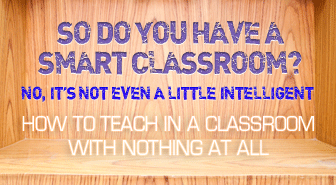So Do You Have a Smart Classroom? No, Itís Not Even a Little Intelligent: Teaching in a Classroom with Nothing at All


“I’ve just started teaching ESL, and I see there is a big trend in education regarding the use of technology in the classroom. What are some creative ways to use technology besides the standard PowerPoint presentation or the interactive online quizzes/programs? Also, I want to make sure I use enough to keep students engaged and that I’m keeping up with the latest technology trends, but how much technology is too much?” *
Some view technology as simply a crutch teachers lean on, because let’s face it…how easy is it to have your class sit in front of some computers to complete a quiz online? But supporters of the use of tech tools in the classroom see it as a way to promote sustainable change. While we may not have a completely paperless classroom, we can save countless trees with the use of electronic tools. You may be on one side or the other, or entirely on the fence. This article may change your mind. But let’s address the second question first.

For a long time now, I’ve stressed the importance of focusing on your students’ needs and defining goals for them to accomplish. So the answer to this question is simple: if you use technological tools that are specifically selected to help your students accomplish their learning goals, then there can never be too much. Now if you use technology for technology’s sake, then you’re heading in the wrong direction.
What does “technology for technology’s sake” mean? You use technology for technology’s sake when:
So, as long as you don’t use technology for technology’s sake and have your students’ needs and goals in mind, there can never be too much technology. Now that said, I still recommend implementing a variety of methods and not relying heavily on technology. Why? Because the use of technology brings its own set of complications; you never know when the school server/Internet may be down, or the connection too slow; you may not have access to the computer lab whenever you like; etc… The more heavily you rely on technology the more “tech problems” you are likely to have. Sometimes the most primitive technologies (i.e. pen and paper) are the best, and a good teacher will know how to achieve the balance between high tech and low tech.

There is a great article on the 10 Types of Technology Every Teacher Should Know How to Use, so instead of launching into a list of tools, I’ll focus on some creative ways to use these very same tools.
There are many things you can do with a cell phone or smartphone, but one of my favorites is the option to record and playback video. Record students as they speak or act out a role play, then play back and show it to them: can they identify the mistakes they made? What expressions should they have used? What would they change? I also like the idea of recording each student, for example, talking about him/herself at the start of the course, and then again at the end of the course, and comparing the two recordings so students can see how much they’ve improved.
USB flash drives, also called thumb or pen drives, are handy little tools, and you should have each student bring their own. Remember those video recordings? Students can take them home and keep them as reminders of their progress.
Why have students only listen to podcasts when they can also create their own? Have them use any recording device, from a smartphone to iPod, and create a short podcast on a topic you’ve been discussing in class. Students then share the MP3 file with you and their classmates. Have a special feedback session to give them corrections and note their use of vocabulary, grammar or make overall remarks on their fluency.
More and more ESL classrooms are being equipped with interactive smartboards, which have come to replace the old blackboard/whiteboard. As for things you can do on a smartboard, the sky’s the limit, but let’s see just one example. Use your smartboard to play games. It’s very simple if you use software like Gynzy’s, which allows you to play a Jeopardy-like game that you design with your own categories and questions.
Take reading tasks to a whole new level by having students carry copies of their books and work in e-readers instead of physical, paper copies. Just think about it. Whether they use a Kindle, iPad or any other tablet, it’s so easy to store PDFs and other documents in these devices. With one tap of their fingers they can have access to an entire content library.
Technological tools should be seen as just that: tools. If you focus on your students’ needs and goals as you choose which tool to use, you can’t go wrong.